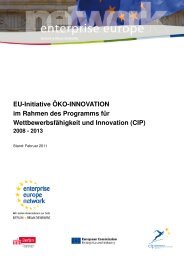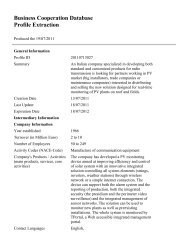Photonics Driving Economic Growth in Europe - Photonics21
Photonics Driving Economic Growth in Europe - Photonics21
Photonics Driving Economic Growth in Europe - Photonics21
Create successful ePaper yourself
Turn your PDF publications into a flip-book with our unique Google optimized e-Paper software.
54 Towards 2020 – <strong>Photonics</strong> driv<strong>in</strong>g economic growth <strong>in</strong> <strong>Europe</strong><br />
A doubl<strong>in</strong>g of the present<br />
efficiency of the OPV is be<strong>in</strong>g<br />
targeted.<br />
It is estimated that a massive<br />
market uptake of OPV will occur<br />
around 2020. © Holst Centre<br />
As with LED technology, system <strong>in</strong>tegration for<br />
creat<strong>in</strong>g user-centric solutions will require the<br />
development of hardware and software architec-<br />
tures, enabl<strong>in</strong>g the <strong>in</strong>teroperability of light sources,<br />
actuators and sensors from different suppliers.<br />
OPV<br />
Initially OPV is expected to penetrate dedicated<br />
niche markets, subsequently lead<strong>in</strong>g to serv<strong>in</strong>g new<br />
volume markets. A notable example of this would<br />
be provid<strong>in</strong>g energy to the 1–2 billion people <strong>in</strong><br />
the world, who will never have direct access to an<br />
electricity grid. This could be the perfect stepp<strong>in</strong>g-<br />
stone for this technology, exploit<strong>in</strong>g the exceptional<br />
robustness offered by OPV <strong>in</strong> comparison to conven-<br />
tional photovoltaic technology. Future mass mar-<br />
kets are anticipated to lie with e-mobility and with<br />
build<strong>in</strong>g-<strong>in</strong>tegrated photovoltaics, which are both<br />
application fields that will profit significantly from<br />
conformable, flexible and transparent solar cells.<br />
The <strong>Europe</strong>an Photovoltaic Industry Association<br />
(EPIA) predicts that this massive market uptake of<br />
OPV will occur around 2020, allow<strong>in</strong>g sufficient<br />
time for OPV technology to improve and outperform<br />
conventional Si-PV technology.<br />
The <strong>in</strong>novation challenges fac<strong>in</strong>g OPV are very<br />
similar to those fac<strong>in</strong>g OLED light<strong>in</strong>g technology.<br />
Major improvements <strong>in</strong> the cost performance ratio<br />
will be required to become competitive with the<br />
established Si-PV technology. To achieve this, a<br />
doubl<strong>in</strong>g of the present efficiency will be needed,<br />
as well as a substantial <strong>in</strong>crease <strong>in</strong> lifetime, and<br />
these targets must be high on the research agenda.<br />
New materials will play a major role <strong>in</strong> achiev<strong>in</strong>g<br />
these improvements. In parallel with this, scal<strong>in</strong>g up<br />
fabrication from cells to modules, and the transition<br />
from ‘lab to fab’ to manage the complexity of the<br />
processes, will both make a major contribution<br />
to cost reduction. However, this goal can only be<br />
reached though a substantial <strong>in</strong>crease <strong>in</strong> <strong>in</strong>vestment<br />
<strong>in</strong> pilot production facilities. There are clear<br />
opportunities for cross-fertilisation between the<br />
technologoies developed for the OLED light<strong>in</strong>g and
















